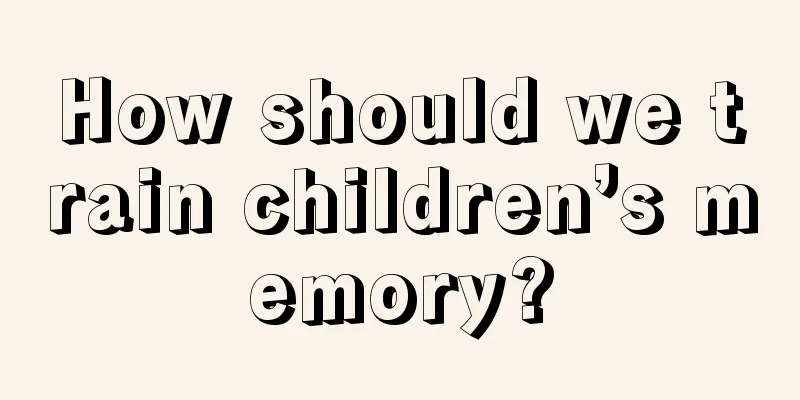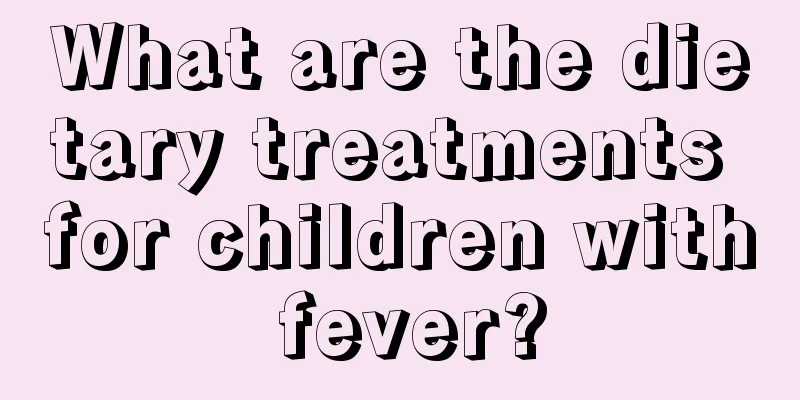How should we train children’s memory?

|
A baby's memory is not entirely innate. In order to cultivate a child's memory, parents should, after understanding their age characteristics, first choose some materials that are vivid, specific, lively and have strong emotional colors, and ask the child to memorize them. Only in this way can children's images be enriched, deep impressions be gained and memory be developed. So, how should we train young children’s memory? Characteristics of early childhood memory: 1. Young children mainly rely on unintentional memory, while intentional memory gradually develops. Throughout the early childhood period, unconscious memory is better than conscious memory. Young children can always remember a lot of things unconsciously in the active cognitive process. 2. Young children mainly rely on image memory, and their verbal and logical memory gradually develops. Young children can easily remember content that is specific, intuitive and vivid, so visual memory is dominant in early childhood. However, when children accumulate more and more words, images and words will support each other in their memory. When a young child recalls something, he can remember what it looks like and say its name. 3. Young children mainly rely on mechanical memory, and are better at meaningful memory. Because young children have relatively limited knowledge and experience and poor comprehension ability, they tend to "memorize by rote". After the age of 4, as children's lives become richer and their comprehension abilities gradually improve, they are gradually able to memorize based on their understanding of the content, and the memory effect continues to improve. Training methods: Play games "Where there is no interest, there is no memory." Goethe's words hit the nail on the head about the baby's memory characteristics. Wise parents never "order" their babies to remember this or that, but let them learn while playing and remember while playing. Games can often repeatedly reflect events that babies have experienced, thereby deepening their understanding and consolidating their memories. Training Examples Today I prepared three plastic cups of different colors and placed them upside down on the table. I also prepared a duck toy. I told Lei Lei, "The duck is going to sleep." Then I put the duck into the bottom of one of the cups. Then I asked him, "Where is the little duck sleeping?" Lei Lei recognized it immediately. Expert Comments This game first stimulates the baby's memory through colors, and then gradually transitions to getting rid of the color "crutch". If the baby doesn't remember during the game, the mother can take out the duckling and say to the baby, "Oh, sleep here!" Then repeat the game, putting the toy back at the bottom of the cup until the baby points out where the duckling is. When the baby becomes proficient, you can change the cup to put the duck, and you can also use cups of different colors to play this game. Acting out a story If parents teach their babies some words in a rigid way, it will not only make the babies feel boring, but also make it difficult for them to remember. So why not try a different approach? Content accompanied by actions or strong emotional experiences will sound more vivid and interesting to your baby, and will also be easier to understand and remember. Training Examples Today I told Qiqi the story of Little Red Riding Hood. After reading the story book, I brought props and asked Dad to play the Big Bad Wolf, I played the grandmother, and Qiqi to play Little Red Riding Hood. After the performance, she was still not satisfied. It turned out that she thought of the Big Bad Wolf who had no mother now, so she started to write and perform it herself... Expert Comments Memorizing certain things through games is an important way to develop your baby's memory. Mothers can create many parent-child games and activities by themselves, which can help train their baby’s memory in a relaxed and happy parent-child fun. While learning, let your baby use as many senses as possible to participate. This will make the impression left in his mind more comprehensive and clearer, and help him remember the content accurately and keep it for longer. Also, don’t deny your baby’s creativity in the plot. We should not stifle our baby's creativity and imagination just because it is memory training. View image Looking at pictures is a form of visual memory. Due to the limitations of their thinking ability, babies rarely gain a deep understanding of the essence of things when observing them. He is only interested in things that are vivid and lively, and his memory is relatively solid. Vivid and intuitive pictures can make learning vivid and intuitive for babies, and also help them understand the vocabulary content. Training Examples Today I taught Ningning the word "Earth". But Ningning was still playing with his electric four-wheel drive car mischievously and had no interest in the literacy cards in my hand. At this time, I suddenly remembered the pictures in the computer, so I copied various pictures of the earth. Suddenly, the charming pictures attracted his attention. Through the picture, Ningning quickly remembered what "Earth" is. Expert Comments The images of specific things that the baby has observed and felt that are stored in his mind are called representations. The more representations are stored, the more helpful it is for the baby to master more knowledge. For example, parents can use simple strokes to briefly outline the shape of the "Earth" and tell their baby about it while drawing. "The earth is the planet we humans live on", "It is round in shape" ... You can also let your baby draw it by himself, and the memory will be more profound by comparing it with his own work. Of course, if conditions permit, parents can also make some slides for their babies, which will make learning more interesting for them. Guess the riddle Guessing riddles can promote the development of baby's intelligence. When the baby listens to the description of the riddle, the image of the relevant things obtained through daily observation will appear in his mind. Only after analysis and comparison can he make a judgment and tell the answer to the riddle. In this process, not only can the baby's attention, observation, thinking, imagination and language expression ability be effectively developed, but also the baby's memory ability is enhanced. It has a good promoting effect on the baby's early intellectual development and is a practical and simple parent-child game. Warm reminder: It is well known that young children’s memory is limited, and the key is continuous training. And each of us, children need more than just a good memory. |
<<: What to do if baby has rash on back
>>: What are the dangers of enlarged tonsils in children?
Recommend
What are the common diseases and care of newborns?
Neonatal disease is a stubborn disease and has ce...
How to correct baby's protruding ears
We often say that babies with protruding ears are...
How many times a day is normal for a newborn baby to poop?
For many newborns, if they want to grow up health...
Can babies eat yogurt when they are 1 year old?
As we all know, the lactobacilli in yogurt are ac...
How to treat tonsillitis in children
Children are the apple of their mother’s eye and ...
What is the cause of white spots in newborns?
There are many factors in life that can cause the...
When does the baby start to change teeth? What should I pay attention to?
When there is a baby at home, parents have to wor...
Why do children have precocious puberty?
In recent years, precocious puberty has become a ...
What are the dangers of childhood obesity?
There are many reasons why childhood obesity rate...
Why does my child keep burping?
Many people have experienced burping, whether the...
Children will die if they get this disease. Parents should wake up.
Although medical conditions are getting better an...
What are the causes of dizziness in 11-year-old children?
Many people often experience symptoms such as diz...
What are the methods of reducing fever in children through medication?
Nowadays, there are a lot of people suffering fro...
One-year-old baby walks with his feet turned inwards
If the baby's feet turn inward when walking, ...
What does pediatric convulsion mean?
When symptoms of pediatric convulsions occur, par...









